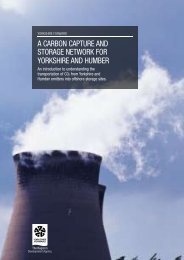Final report for One North East And NEPIC 21/12/10 - The Carbon ...
Final report for One North East And NEPIC 21/12/10 - The Carbon ...
Final report for One North East And NEPIC 21/12/10 - The Carbon ...
You also want an ePaper? Increase the reach of your titles
YUMPU automatically turns print PDFs into web optimized ePapers that Google loves.
<strong>The</strong> case <strong>for</strong> a Tees CCS network<strong>Final</strong> ReportEventually, when project risks can be suitably understood and managed, and where thecarbon market and regulatory frameworks provide the necessary economic drivers/support<strong>for</strong> investment, the private sector should be able to mobilise the necessary resources tofinance and promote the project (right hand side of Figure 17). However, whist CCSremains unproven at scale and the required support framework is still emerging, projectpromoters are likely to require some <strong>for</strong>m of public sector involvement.When appraising project finance decisions, all capital providers undertake rigorousquantitative analysis to understand the commercial implications of „worst case scenarios‟<strong>for</strong> the cash flow model. For a CCS network, there are many factors potentially contributingto a worst case scenario (project failure, stranded assets and significant, potentiallyunlimited, liabilities). Even where key „deal breakers‟ can be resolved and counterpartyrisks insulated, expectations of the potential <strong>for</strong> project failure, commercially as well astechnically, are reflected in capital lending terms i.e. project returns over time. Equity is theonly option <strong>for</strong> private finance where projects are deemed too high risk to attract debtfinance; beyond certain levels of commercial risk, only public sector investment can beconsidered viable.<strong>The</strong> sources of finance <strong>for</strong> a Tees Valley CCS network considered here are :Grant <strong>The</strong>se include the EU NER 300 and UK CCS demonstration funding. Significantlevels of grant will be required to help offset the large capital requirements <strong>for</strong> buildinga CCS network. Furthermore, several potential developments within UK policy mayoffer further support <strong>for</strong> CCS, although their details remain largely unresolved atpresent. 86 <strong>The</strong>se could include the introduction of a CCS Levy on electricityconsumers, the use of ETS carbon floor prices to insulate operators from future EUAllowance price uncertainty, and various mechanisms operating under a newlyestablished UK Green Investment Bank (e.g. grants, soft loans, venture capitalfinance, project guarantees). <strong>The</strong> Global CCS Institute (GCCSI) – an Australian-ledinitiative designed to accelerate the commercial deployment of CCS projects - also hassmaller funds available to support project development via is Project Funding andSupport Programme. <strong>The</strong> fund has about AU$50 M (approx £30 M) annually available<strong>for</strong> project implementation. <strong>The</strong> fund recently awarded the Rotterdam ClimateInitiative (RCI) AU$2.2 M (approx. £1.2 M) <strong>for</strong> an independent assessment of storagesites, a feasibility study in to transport options – including shipping – and a project„benefits‟ assessment. In the future, other national, European, or global transportinfrastructure public funds may become available <strong>for</strong> CCS infrastructure.Equity. Major emitting plants and potentially other interested corporate parties(chemical companies, manufacturers, utilities, midstream specialists, storageoperators etc.) could take an equity stake in a pipeline infrastructure SPV company (orseparate onshore and/or offshore SPV companies). Equity requires higher projectreturns to shareholders than debt finance, but guarantees a firm commitment to projectsuccess by the parties involved. In order to retain good credit-worthiness, anyinvestment in CCS would likely need to represent a small share of the parentcompany‟s overall asset base to limit exposure (<strong>for</strong> example, limited to around 2% ofthe corporate asset base etc.). Capital investment would almost certainly be needed tobuild each network user‟s capture plant, and in some cases may be within the scope oftypical on-balance capital budgets (as suggested by discussions with Teessidestakeholders - see Appendix 1).86 <strong>The</strong> degree to which these are paid out up-front or based on per<strong>for</strong>mance (e.g. through a contract-<strong>for</strong>differencewith the carbon price) has not yet been determined.49







